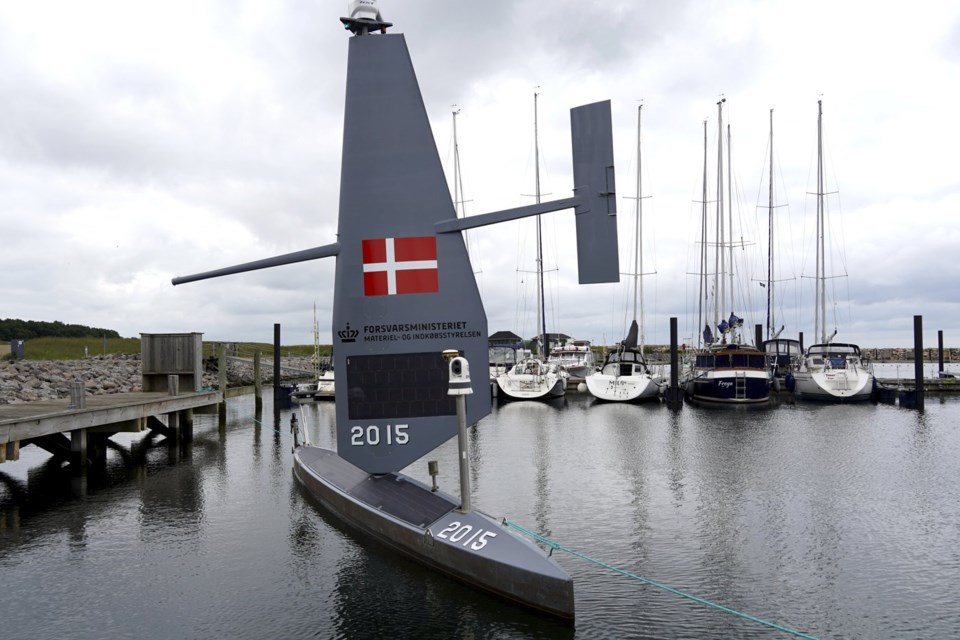KOGE MARINA, Denmark (AP) — From a distance they look almost like ordinary sailboats, their sails emblazoned with the red-and-white flag of Denmark.
But these 10-meter (30-foot) -long vessels carry no crew and are designed for surveillance.
Four uncrewed robotic sailboats, known as “Voyagers,” have been put into service by Denmark's armed forces for a three-month operational trial.
Built by Alameda, California-based company Saildrone, the vessels will patrol Danish and NATO waters in the Baltic and North Seas, where maritime tensions and suspected sabotage have escalated sharply since Russia’s full-scale invasion of Ukraine on Feb. 24, 2022.
Two of the Voyagers launched Monday from Koge Marina, about 40 kilometers (25 miles) south of the Danish capital, Copenhagen. Powered by wind and solar energy, these sea drones can operate autonomously for months at sea. Saildrone says the vessels carry advanced sensor suites — radar, infrared and optical cameras, sonar and acoustic monitoring.
Their launch comes after two others already joined a NATO patrol on June 6.
Saildrone founder and CEO Richard Jenkins compared the vessels to a “truck” that carries sensors and uses machine learning and artificial intelligence to give a “full picture of what's above and below the surface" to about 20 to 30 miles (30 to 50 kilometers) in the open ocean.
He said that maritime threats like damage to undersea cables, illegal fishing and the smuggling of people, weapons and drugs are going undetected simply because “no one’s observing it.”
Saildrone, he said, is "going to places ... where we previously didn’t have eyes and ears.”
The Danish Defense Ministry says the trial is aimed at boosting surveillance capacity in under-monitored waters, especially around critical undersea infrastructure such as fiber-optic cables and power lines.
“The security situation in the Baltic is tense,” said Lt. Gen. Kim Jørgensen, the director of Danish National Armaments at the ministry. “They’re going to cruise Danish waters, and then later they’re going to join up with the two that are on (the) NATO exercise. And then they’ll move from area to area within the Danish waters."
The trial comes as NATO confronts a wave of damage to maritime infrastructure — including the 2022 Nord Stream pipeline explosions and the rupture of at least 11 undersea cables since late 2023. The most recent incident, in January, severed a fiber-optic link between Latvia and Sweden’s Gotland island.
The trial also unfolds against a backdrop of trans-Atlantic friction — with U.S. President Donald Trump's administration threatening to seize Greenland, a semiautonomous territory belonging to Denmark, a NATO member. Trump has said he wouldn't rule out military force to take Greenland.
Jenkins, the founder of Saildrone, noted that his company had already planned to open its operation in Denmark before Trump was reelected. He didn't want to comment on the Greenland matter, insisting the company isn't political.
Some of the maritime disruptions have been blamed on Russia’s so-called shadow fleet — aging oil tankers operating under opaque ownership to avoid sanctions. One such vessel, the Eagle S, was seized by Finnish police in December for allegedly damaging a power cable between Finland and Estonia with its anchor.
Western officials accuse Russia of behind behind a string of hybrid war attacks on land and at sea.
Amid these concerns, NATO is moving to build a layered maritime surveillance system combining uncrewed surface vehicles like the Voyagers with traditional naval ships, satellites and seabed sensors.
“The challenge is that you basically need to be on the water all the time, and it’s humongously expensive," said Peter Viggo Jakobsen of the Royal Danish Defense College. “It’s simply too expensive for us to have a warship trailing every single Russian ship, be it a warship or a civilian freighter of some kind.”
“We’re trying to put together a layered system that will enable us to keep constant monitoring of potential threats, but at a much cheaper level than before,” he added.
James Brooks, The Associated Press



